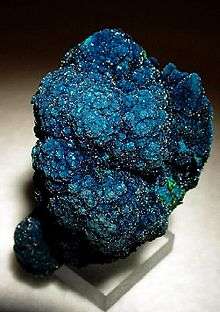Cornetite
Cornetite is a phosphate of copper with hydroxyl named after the geologist Jules Cornet. It was discovered in 1917.
| Cornetite | |
|---|---|
 Cornetite from the type locality, Star of the Congo Mine, Lubumbashi, Haut-Katanga District, Democratic Republic of the Congo. 5.7 × 3.9 × 3.9 cm in size | |
| General | |
| Category | Phosphate minerals |
| Formula (repeating unit) | Cu3PO4(OH)3 |
| Strunz classification | 8.BE.15 |
| Dana classification | 41.03.02.01 |
| Crystal system | Orthorhombic |
| Crystal class | Dipyramidal (mmm) H-M symbol: (2/m 2/m 2/m) |
| Space group | Pbca |
| Unit cell | a = 10.845(10) Å, b = 14.045(10) Å, c = 7.081(5) Å; Z = 8 |
| Identification | |
| Formula mass | 336.63 g/mol |
| Color | Dark blue to green-blue |
| Crystal habit | Crystals are short prismatic |
| Twinning | On {h0l} |
| Cleavage | None observed |
| Mohs scale hardness | 4.5 |
| Luster | Vitreous |
| Diaphaneity | Transparent to translucent |
| Specific gravity | (Measured) 4.10 |
| Optical properties | Biaxial (-) |
| Refractive index | nα = 1.765 nβ = 1.810 nγ = 1.820 |
| Birefringence | δ = 0.055 max |
| Pleochroism | non-pleochroic |
| 2V angle | Measured: 33° , Calculated: 48° |
| Dispersion | none |
| Solubility | cold HCl |
| References | [1][2][3][4] |
Type Locality
Cornetite is most notably found in the Star of Congo mine, near Lubumbashi.
Environment
Cornetite is a rare secondary mineral in some hydrothermal copper deposits.
Structure
Unlike related phases such as Pseudomalachite, the copper atoms are all five-fold coordinated by oxygen. There are three unique copper sites that are all quite distorted from ideal symmetry. Two are in approximate tetragonal pyramids and the third is essentially a trigonal bipyramidal coordination. Edge sharing polyhedra lead to copper-copper dimer formation, and the overall structure is a three-dimensional network of copper-oxygen polyhedra.[4]
gollark: I could add some fun "potatOS system dump" mode, yes.
gollark: Ah, of course.
gollark: `string.dump(string.dump)`
gollark: This is ***evil*** code.
gollark: Not my code.
References
| Wikimedia Commons has media related to Cornetite. |
- http://www.mindat.org/min-1131.html Mindat.org
- http://webmineral.com/data/Cornetite.shtml
- http://www.handbookofmineralogy.org/pdfs/cornetite.pdf Handbook of Mineralogy
- Fehlmann, M.; Ghose, Subrata; Finney, J. J. (1964). "Direct Determination of the Crystal Structure of Cornetite, Cu3PO4(OH)3, by the Monte Carlo Method". J. Chem. Phys. 41: 1910. doi:10.1063/1.1726182.
This article is issued from Wikipedia. The text is licensed under Creative Commons - Attribution - Sharealike. Additional terms may apply for the media files.